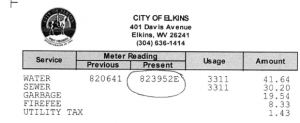What’s with the “E” on my water bill?
 If you see an “E” next to the number in the “present” column of your water bill, you are looking at an “estimated reading.”
If you see an “E” next to the number in the “present” column of your water bill, you are looking at an “estimated reading.”
The water meters in use here in Elkins have built-in transmitters that are supposed to automatically send water usage information to our water utility’s billing department. However, as you may have heard, our remote-read water meters are getting old. About 600 of them no longer have working transmitters, and we are working on a project to replace them later this year. (More on that below.)
Again, all that is broken are the transmitters–these meters still record usage information accurately. However, we don’t have the workforce to read that many meters manually every month. Instead, several readings in a row may have to be estimated, based on the average of the most recent 12 remote-read months. (In that case, you’ll see an “E” on your bill.) Then, when a manual reading is taken, the actual cumulative total usage is recorded and billed (which corrects for any under- or over-estimation).
The city plans to replace our current remote-read water meters but cannot yet announce a date when this project will be complete. Several steps are still pending, including project approval from the USDA (the source of the money, which comes from unexpended water-plant construction funds), open bidding for a contractor to complete the project, and custom coding of a module in our billing software for importing usage data from the new meters. This project is estimated to cost $1.2 million.
We’ll update you as soon as this project gets rolling and we can firm up the projected completion date.
Disclaimers and fine print: We can only pay for new water meters with funds from the water utility—in this case, those funds left over after completion of the water-plant construction project. Those leftover funds, in turn, can’t be used for anything but water system projects. If we returned that leftover money to the lender, it wouldn’t lower water rates, and then we’d need a new loan (and a new water-rate increase) to fund replacing the water meters. Replacing the water meters this way will not require a rate increase (but remember, we are still awaiting USDA approval to use the money this way).
New Web Page: Water Outages FAQ
Water leaks and outages affect all water systems. Starting in 2021, however, our system began seeing a significant increase in such incidents, especially in South Elkins. This year, Elkins water system workers have responded to dozens of leaks in South Elkins. Although […]
Read MoreWhy So Many Water Outages?
There is clearly an unacceptable number of ongoing water outages and sometimes resulting Boil Water Notices. What is going on? One major reason is that many underground water lines in Elkins are past their end-of-life and need to be replaced. The reason […]
Read MoreKeeping Our Drinking Water Flowing
So far in 2021, Elkins Water System employees have responded to about five dozen broken water mains. This is in addition to performing planned work to replace fire hydrants, faulty valves, and related maintenance and upgrades essential to keeping drinking water flowing […]
Read More